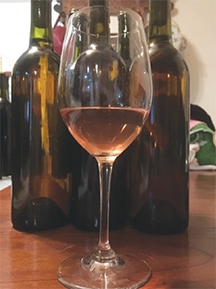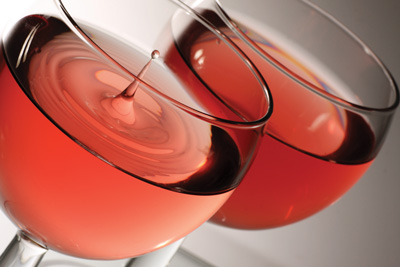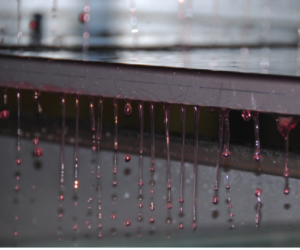 In a recent study commissioned in the UK, researchers studied the sociological data of people who expressed a preference for either red or white wine. In addition to mundane facts (red wine drinkers have a slightly higher rate of college degrees, white wine drinkers are content stay-at-homes) a couple of very interesting things emerged: fans of rosé wine seek change in their life, and want to challenge the status quo. They also were the most likely to be in happily settled relationships, and were described as “warm and charming.”
In a recent study commissioned in the UK, researchers studied the sociological data of people who expressed a preference for either red or white wine. In addition to mundane facts (red wine drinkers have a slightly higher rate of college degrees, white wine drinkers are content stay-at-homes) a couple of very interesting things emerged: fans of rosé wine seek change in their life, and want to challenge the status quo. They also were the most likely to be in happily settled relationships, and were described as “warm and charming.”
Any true lover of rosé could have saved them the cost of the study: it’s immediately obvious that people who like pink wine are flat-out cool and enjoy the important things in life. And that goes double for people who make their own rosé at home.
Nothing is as versatile or as satisfying as a good rosé wine — can’t decide what will pair with your dinner better, red or white? Drink pink — with the body of red and the crispness of white it can match anything. Rosé-style wine kits are also available year-round, and if you’re feeling quite adventurous, there are even other paths to achieving pinkness . . . if you’re willing to try something that challenges the status quo.
What kind of rosé?
There are many different types of rosé, and different paths to getting there. The traditional French styles, especially those from the southern Rhône or from Anjou, would seem a big departure from the breezy, often sweeter, California blushes and White Zinfandels, Merlots and Cabs. Part of this differentiation comes from the methods of production.
Commercial styles can be divided into three categories:
1. Immediately pressing red grapes after crushing to make a very pale pink wine.
2. Short maceration (contact with the skins, where all of the color of the grape is) of red grapes before pressing.
3. Blending a small amount of finished red wine into white.
The first technique, using red grapes as though they were white, produced America’s most famous pink wine: White Zinfandel. Because rosé wines were suffering from a loss of market share at the time White Zin became popular, they were referred to as “blush wine” rather than rosé. Other varietals have been used, including Grenache, Cabernet Sauvignon, Merlot and Pinot Noir. Most of the wines made this way tend towards the sweeter side.
The second technique makes some of the finest and most refined rosés, including those of Provence, Anjou, the Loire in France and the Rosado’s of Spain — European drinkers take their rosé more seriously than the rest of the world, with Provence alone making more than 150 million bottles a year.
Rather trickily, the short-maceration technique is also used with some grapes that are not primarily intended to make rosé, in a scheme called saignée. In these wines the grapes are allowed to macerate for a short period and then a portion (but not all) of the free-run juice is removed (“bled off,” which is what saignée means in French) and used to make a light-to-medium pink wine. The rest of the juice is allowed to sit with the skins and seeds. By reducing the volume of the liquid, the concentration of color and phenolics (tannins) in the remaining red wine maceration will be darker and more concentrated in flavor and aroma.
The last technique might seem like cheating, in a way, but it’s the way lots of French rosé Champagne is made — the Champenoise would certainly not take well to being called cheaters! It would be much too hard to judge the color and character of a sparkling wine by using a portion of early pressed grapes. It’s actually this technique that kit winemakers can use to fashion their own rosé, when they want to try something different from rosé kits available from their local winemaking shop. It’s also an excellent technique for extending the range of your cellar from existing wine — more on that to come if you read on.
Choosing a rosé
A survey of the major kit manufacturer’s websites shows White Zinfandel, White Merlot, Grenache, Shiraz, Malbec, Pinot Noir, Blush, pink “mist” type fruit and wine beverages, from places ranging from Argentina, Chile, California, and Australia. Recent limited-release/seasonal wines have been
from France and Spain. Each of these kits reflects the terroir of the regions they are from, but more importantly they reflect rosé winemaking styles most closely associated with their regions.
Kits that are not country or appellation designated, or those that contain the word “blush” or “white” in their name almost always reflect the style of Zinfandel blush popularized by the commercial winery Sutter Home in the late 1980s: broadly fruity flavors, medium to quite sweet on the palate and moderate-to-low alcohol content. These are the happy, easy-drinking pink wines that introduced a lot of people to the pleasures of the grape.
Kits that are country or appellation designated, or feature the actual word rosé in their description, are much more likely to be significantly drier, and will show the broad style of the countries they’re from. French and Spanish wines will often be made from Grenache, so chosen because it has low levels of phenolics to start with, and can take a day or so of skin contact without getting significant astringency. Perhaps the best way to describe them is to note that philosophically they’re intended to resemble light, crisp red wines, if that makes sense.
Rosé kits from other countries are harder to broadly define, but expect Argentinian and Chilean wines to really emphasize varietal character, Australia to punch up fruitiness, and California to be all over the map. Consult your retailer for more information on each individual kit.
Pink versions of Mist-type kits, with their low alcohol/high residual sugar flavor profile are a lot of fun to drink, but are really in the category of “refreshment beverages” as opposed to table wine. Make ‘em if you like ‘em, but you’ll need to rely on the manufacturer’s description or advice from your shopkeeper to figure out if the flavor profile suits your taste.
Making a rosé kit
You won’t have to worry about pressing grapes or doing saignée on the kit you choose. It will arrive a light red/deep pink color, ready to ferment. As with all kits the single most important thing you can do as a first-time rosé maker is to follow the instructions completely, making no change however small, omitting no detail, however slight. Follow (and measure/record) starting temperature recommendations, hit your racking days and be sure to add any sweetening packs when recommended. The temptation might be to ferment these wines cooler to retain fruitiness, but that’s not going to help, really, and some of the greatest pink wines come from countries where it’s only possible to keep fermentations below 100 °F (38 °C) with massive intervention.
Interestingly, many rosé kits will clear faster than whites, due to some of the phenols acting as an opposing fining agent to protein or polysaccharide fining agents (isinglass, chitosan, etc.) When directed, bottle, cork and wait at least one month before trying the first bottle — while these wines generally improve for at least a full year in the bottle, and normally hold that long again without significant flavor or aroma loss, most are great very young, especially off-dry or sweet versions that have had a sweetening dose added to them post-fermentation.
Pink or orange?
It is true that the wines will hold without flavor or aroma loss, but there could be an issue with the color. Most people expect rosé wine to be a bright pink, with hints of purple hue, and when they are very young, that’s what you’ll see. However, this changes with time, and many of these wines will begin to show a distinct orange-salmon hue as they get older in the bottle.
This isn’t because they are spoiling: it’s due to the nature of pigments in red grapes. In addition to true red colors, red or black grapes contain blue pigments, giving their juice a rich purple color. The blue pigment is less stable than the red and degrades or bonds chemically in the wine much faster than the red. The result is the loss of purpleness and a rise in a brick-red color. The very same thing happens in red wines, but because of the higher levels of pigment in them, it’s less easy to see.
What should you do if your pink wine goes light orange? Not a thing: this phenomenon has been observed for thousands of years. The French call it “œil-de-perdrix,” or “eye of the partridge,” because of that bird’s distinctive bright orange iris. They originally applied it to very pale Pinot Noir wines, but it’s come into common use in tasting notes to describe pink wines that have this hue. The wine will still be delicious, and the only time you should worry is if it looks dull brown — by that time you’ll know the wine is oxidized as soon as you open a bottle and smell that dull, sad aroma.
Blending your own
If you’d like to try your hand at a little wine artistry, you can whip up some rosé from wines you already have on hand. For the base wine you’ll need a fruity, crisp white. Think Sauvignon Blanc, dry Riesling, or similar. Off-dry wines work as well, but make sure they’ve got some decent acidity as well or they may take on too much sweet character, which is okay if that’s your thing, but it’s better to be able to sweeten the wine after blending for more control.
For the red addition you’ll want to choose a low-to-no oak red. While it’s possible to use lightly oaked reds, anything that’s got more than a couple of ounces of oak in the batch might leave an oaky note in the finished rosé, which can be quite disconcerting in something that’s supposed to emphasise fruit, especially if it’s finished off-dry or sweet.
Good candidates are varietals that have decent phenol profiles and good varietal character. Malbec is excellent, as is Syrah/Shiraz, Zinfandel (of course!), while Cabernet Sauvignon and Merlot are good if you can get one that isn’t oozing oak.
The easiest way to make these blends is from any white that you’re already going to bottle on that day, and a bottle or two of your desired red. Set up a bench trial by measuring out 100 milliliters (mL) of your base wine into ten small plastic cups. Then, using a syringe or pipette for accuracy, dose each wine with 1 mL of red, going up another 1 mL in each succeeding cup until you’ve finished with 100 mL of white wine and 10 mL of red. Observe the colors, and then taste the wines to see which one tastes best.
Without knowing the specific base wine you’ll be using, it’s difficult to give a rule of thumb for how much it’s going to be, but most rosé wines made from blends are between 5 and 10%. Pick the one you like best and then compare it with the wines on each side, one mL more, one mL less. Take your time and enlist a second opinion if you can round one up. If you find that 10% isn’t enough (say if you’re using Pinot Noir) then you may want to set up another trial ranging from 10%–20%, although at that point you’ll be making a wine the Italians call chiaretto and the Spanish call claret, light red rather than pink wines — which is not necessarily a bad thing, if it suits your taste. Once you’ve figured out the percentage of red to blend in, determine how many bottles of wine you want to make, multiply that by 750 to get the number of mL, and then apply that to your percentage. For example, if you’re making 12 bottles with a 5% addition, 12 x 750 = 9000 mL; 5% of 9000 = 450 mL of red. Rack 9 liters of white wine into your bottling bucket; gently add 450 mL of your red, stir very gently to mix and then bottle.
Now in addition to a good red and a nice white, your cellar contains a beautiful pink — and that’s a fine thing to have!







